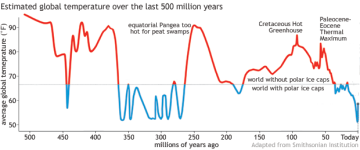2023 has been a disastrous year for global warming. Just look at the chart below. In the 80 years between 1942 and 2022 the average global temperature has increased from 15.4°C to 16.4°C. That's only 1 degree in 80 years, i.e. an average of +0.0125°C per year. But 2023 has seen a sudden rise of almost +0.4°C in a single year! That's a rate of warming 32 times faster than the last 80 years!

To put in perspective, the world is trying to limit global warming to a range of +1.5°C to +2°C by 2100 compared to pre-industrial times. Yet, global temperatures have jumped 0.4°C just in 2023. In 2022 the world was +0.8°C above pre-industrial levels. We are now at +1.2°C. Hopefully that's just an anomaly and temperatures won't continue to rise as fast the following years, otherwise we will have exceeded the +1.5°C next year and the +2°C in two years' time.

This video of The Economist shows what the world would look like at +3°C of global warming.
It is generally considered that a world 4°C warmer than pre-industrial levels would be unrecognisable and mostly unliveable for humans. The Amazon forest would turn into a giant desert, as would most of the USA, southern Europe, South Asia, Southeast Asia, China and Japan. All these regions would become uninhabitable (in yellow and brown in the map below). Land in red on the map would be lost to the rising sea levels. At +4°C, sea levels would be somewhere between 7 and 11 metres higher than today - enough to put all coastal cities under water.

If the global temperatures keep increasing like at the same speed as in 2023 (+0.4°C), then we will reach +2°C of global warming in 2025, +3°C in 2028, and +4°C in 2030! That's in seven years!
Improbable, you would think. Indeed it's unlikely that temperatures keep rising as fast as this year. Unless temperatures have started a snowball effect in which:
To put in perspective, the world is trying to limit global warming to a range of +1.5°C to +2°C by 2100 compared to pre-industrial times. Yet, global temperatures have jumped 0.4°C just in 2023. In 2022 the world was +0.8°C above pre-industrial levels. We are now at +1.2°C. Hopefully that's just an anomaly and temperatures won't continue to rise as fast the following years, otherwise we will have exceeded the +1.5°C next year and the +2°C in two years' time.
This video of The Economist shows what the world would look like at +3°C of global warming.
It is generally considered that a world 4°C warmer than pre-industrial levels would be unrecognisable and mostly unliveable for humans. The Amazon forest would turn into a giant desert, as would most of the USA, southern Europe, South Asia, Southeast Asia, China and Japan. All these regions would become uninhabitable (in yellow and brown in the map below). Land in red on the map would be lost to the rising sea levels. At +4°C, sea levels would be somewhere between 7 and 11 metres higher than today - enough to put all coastal cities under water.
If the global temperatures keep increasing like at the same speed as in 2023 (+0.4°C), then we will reach +2°C of global warming in 2025, +3°C in 2028, and +4°C in 2030! That's in seven years!
Improbable, you would think. Indeed it's unlikely that temperatures keep rising as fast as this year. Unless temperatures have started a snowball effect in which:
- Extreme hot summers in Canada and Siberia, with temperatures over 35°C, cause uncontrollable forest fires, releasing tremendous quantities of CO2 into the atmosphere, which in turns accelerates global warming, which in turns causes always more wild fires every year.
- The permafrost in Siberia and Canada thaws, liberating vast quantities of underground methane into the atmosphere - methane that had accumulated over millions of years from the decomposition of trees. Methane is a greenhouse gas 20 times more potent than CO2.
- The Arctic and Antarctic ice sheets are getting smaller, reflecting less sunlight into space, and therefore accelerating global warming each year.


